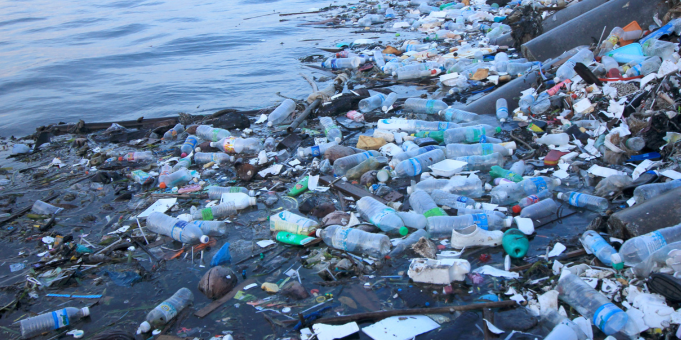An iconic movie of the 1960s, The Graduate, ended with a scene in which a rich older man advised the movie’s young central character played by Dustin Hoffman to succeed by finding a job that dealt in some way with plastics. Good financial advice at the time perhaps. But for the environment, catastrophically awful. It was in the 1960s that the world’s entanglement with plastics had its beginning. I remember finding Tupperware, a brand of kitchen plastic storage containers, remarkably useful back then.
Anything made with plastic will never degrade, never compost, never disappear. Given time, it will break up into minuscule pieces and litter the land and ocean virtually forever. Today more than 170 trillion plastic particles weighing 270,000 tons float on the world’s oceans.
By 2050 the ocean could contain more plastic than fish. Plastics are found in the incredible ocean depths of the Mariana Trench. A survey of coral reef ecosystems have found them swirling with plastic particles. One estimate puts the amount of plastic sequestered in those coral systems weighing in at 44 million pounds.
Plastic pollution touches every nook and corner of our planet. From the Mediterranean to the Arctic to the Great Lakes. Millions of nanoplastic flakes will fall around your head if you stand outside in the Alps.
By now, one million single-use plastic bottles are bought around the world every minute. Five hundred million tons of plastic were produced in 2020. Last year 900 percent more plastic was manufactured than in 1980. ‘Chemical recycling’ of plastic is not recycling; it generates large quantities of hazardous waste including air pollution, not to mention that it’s cheaper to produce new plastic than to recycle it.
Most chewing gum contains plastic. Tires are made with plastics; tiny plastic particles chip off the tire into the air as the car moves. Cheap fast fashion depends on micro plastics and sheds those fibers with wear. By just walking around in synthetic clothing, a person might shed a billion microfibers a year, which can then be inhaled. Even natural fibers these days are usually soaked in plastic-based additives. Organic cotton fabric is made without plastic but is usually dyed and further treated with synthetic dyes to be tougher and waterproof. A load of laundry releases hundreds of trillions of tiny nano plastic particles. Take-out coffee cups release tens of thousands of microplastics and millions of nanoplastics, along with toxins like lead, arsenic and chromium, into the hot water in just 15 minutes. Every one of the masks we wore during Covid releases 1.5 million microplastics as it decomposes.
Bottles, grocery store produce bags, cling wrap, shampoo and toothpaste containers, dry cleaning bags, TV screens, ship paint, on and on and on –all are made of or with plastic.
“When you wash your synthetic clothes, such as stretchy underwear or yoga pants, synthetic fibers flush into a wastewater treatment facility,” a new book, A Poison Like No Other, tells us. From there, they’ll either be pumped out to a body of water, only to be burped back onto land, or sequestered in sludge and spread on fields, only to be scoured by winds and taken up into the atmosphere. They’ll blow hundreds, perhaps thousands of miles and fall on a mountain or in a rainforest or Tibetan lake. Some will drop into the sea, where they’ll cruise around on currents gathering plastispheres, maybe even ones thick enough to sink to the sea floor. “It’s a journey that petroparticles have been making for three-quarters of a century.”
While macroplastics kill larger animals such as sea turtles, microplastics are small enough to infiltrate every body of every animal, including humans, on Earth. One scientist estimates we are inhaling up to 7,000 microparticles a day, or 2.5 million annually. Toddlers spend a lot of time crawling on the floor where microfibers accumulate, not to mention they like to chew on plastic toys, so their intake of plastic will be higher.
Some Solutions
Legislative: California has passed legislation that requires single-use plastic to be reduced by 25% and entirely recyclable or compostable within ten years.
Personal: Stop buying plastic wrapped foods. Use glass containers to store left-overs. Vacuum often and carefully dispose of the vacuum bag. Buy a filter to attach to your washing machine to catch the fibers before they are flushed out–Planet Care is one. (France is set to make washing machines with such a filter built-in, in two years ). Bring your own ceramic cup if you buy coffee outside your home. Buy second-hand clothes. Buy clothing made out of recycled plastic such as running shoes manufactured by Adidas.
For more information:
- 5 Gyres Institute, 5792 W Jefferson, Los Angeles 90016, 310-998-8626
- Beyond Plastics, c/o Bennington College, One College Drive, Bennington, VT’ 05201, 802-422-5401
- ThredUp.com, a source for second hand clothing
- A Poison Like None Other by Matt Simon, published by Island Press
Alice Shabecoff is a resident of Newton.


Recently on Twitter